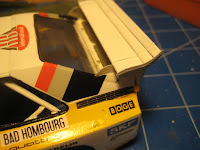Matra was a French airplane manufacturer with an automotive branch. They made a couple of rather odd-looking little sports cars, of which probably the best looking was the Djet; the best that could be said of its successor, the 530, was that it was homely.
Of greater interest to this blog is the fact that they also supported a serious racing program in both F1 and at Le Mans. The F1 program involved producing complete cars (1967 to 1972) and engines only (1975-1982); Jackie Stewart won the championship in a Matra-Cosworth in 1969.
They did well at Le Mans as well, with outright wins in 1972, 1973 and 1974. Henri Pescarolo drove to the win in all three years, with either Gerard Larousse or Graham Hill as co-driver. The car was the MS 670 with Matra's in-house V12.
A series of road racers predated the 670: 620, 630, 650 and 660. All were successful in their various classes. The history books skip over the MS 640, and for good reason: the only prototype ran once in practice at Le Mans, crashing heavily due to aerodynamic lift at high speed. The driver, Pescarolo, was almost killed. A second car has been built recently by fans from original drawings.
So if you were going to build a model, would you pick the successful MS 670? If you are a quirky French firm, you might also model the quirky MS 640.


Profil 24's model of the MS 640, bracketing their MS 630 and MS 650, is unfortunately curbside, and includes just 28 resin parts. A small photo-etched sheet rounds out the kit. While it would be nice to build up a Matra V12, perhaps there is time to complete a curbside kit before I have to move out so the contractors come in and trash the place.

As there is no engine detail, there will be no excuse for not lavishing extra time on a perfect finish, and in that context I am going to attempt to highlight the panel lines. This starts with the panel scribe to widen and deepen the very narrow molded-in gaps, being careful not to slip out of the existing groove and create new ones.

One question will be the potential for damaging mold release agents, which have plagued me in the past. This time I used a brief bath in acetone, rather than isopropyl alcohol, combined with vigorous scrubbing. There are blotches on the underside of the rear fenders and front lip that are suspicious to me, but that did not appear to soften with brief exposure to acetone. (I was unwilling to risk wrecking the kit with extended soaking). Next was a couple of coats of Dupli-Color sandable primer, which has proven to be better able to handle small amounts of release agents than the Tamiya primers.

Fortunately there is pitting but no wholesale lifting of the paint, at least not yet - the application of the final top coat will tell the tale. (That is the sound of me bowing to the Prophet Murphy, who swoops down on overly-confident people and causes unbelievable screw-ups. Hail Murphy! Behold, I am your Servant! Please Have Mercy.) So next will be a bit of putty, some sanding, and another coat of the Dupli-Color. Once that is all good, I'll move to Tamiya primers and the French Blue that was too dark for the Gulf Oil cars.

So another quirky, oddball kit of a quirky, oddball car. Stay tuned!












































